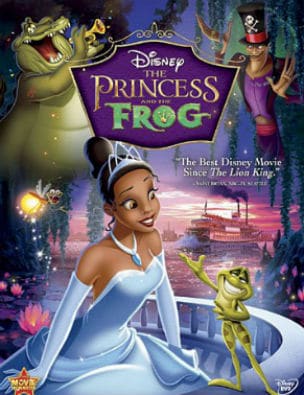
Welcome to Revisiting Disney! This week, we’re looking at a Disney movie that features both the first African American Disney princess and the first workaholic Disney princess, The Princess and the Frog! Like always, I have labeled each category so if you want to skip to the parts that interest you most, feel free to do so. And, of course, if you have any thoughts, burning or otherwise, please share in the comments!
BACKGROUND OF THE PRINCESS AND THE FROG
Released on December 11th, 2009, I remember being very upset when The Princess and the Frog came out. I was a senior in college and trying to be more aware of the political world around me, and I knew that New Orleans was still in rough shape. To me, it seemed very insensitive to make a movie set in New Orleans at this time, unless part of the money was going to cleanup efforts (the Directors, in their commentary, describe the film as “a Valentine to new Orleans,” so it’s probably just a victim of bad timing).
So I waited to see it until it hit the local discount theater, and I was surprised in the best possible way by what I saw. I love The Princess and the Frog. It’s ironic, isn’t it? The animation is gorgeous, the setting (New Orleans in the 1920’s) is fun, and I love the characters. I love Tiana, the Disney princess who has to learn that sometimes it’s okay to have fun and take a day off. Her best friend, Charlotte, is amazing as the grown woman who spends her entire life wishing on stars and waiting for a prince.
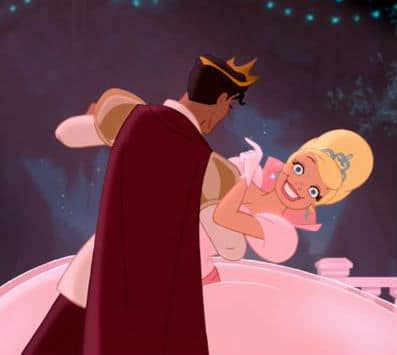
Photo: Disney
Their friendship, actually, is great because Tiana and Charlotte just work as friends, complementing each other in the best way. I also love Prince Naveen, the prince who has to learn the value of hard work. He and Tiana play off of each other very wonderfully, and the villain for this film? Terrifying and hilarious with an amazing villain song.
The Princess and the Frog was written and directed by Ron Clements and John Musker, the team who brought us The Great Mouse Detective, The Little Mermaid, Aladdin, Hercules, and Treasure Planet. They are currently working on Moana (to be released in November 2016).
There was quite a bit of controversy around The Princess and the Frog, which I’ll dig into a little more in the Source Material section. Other notes that I want to make here is that this was the first Disney Animated Film to be released in the month of December since The Emperor’s New Groove. It was also nominated for the Academy Award and the Golden Globe for “Best Animated Feature Film,” although it would lose to Up.
MUSIC
The music and lyrics for The Princess and the Frog were written by Randy Newman, and the songs “Almost There” and “Down in New Orleans” were both nominated for an Academy Award in 2010 (in the category, “Best Achievement in Music Written for Motion Pictures, Original Song). This was the first time since The Lion King that this had happened.
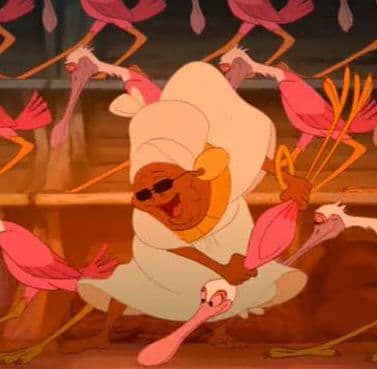
Photo: Disney
Dr. John performed “Down in New Orleans,” while “Never Knew I Needed” was performed by Ne-Yo. The Grammy-nominated Anika Noni Rose plays Tiana and sings the prologue, the song “Almost There,” and sings “When We’re Human” with Michael-Leon Wooley, and Bruno Campos (Naveen). Keith David sings the villain song, “Friends on the Other Side,” while Jim Cummings sings “Gonna Take You There,” and “Ma Belle Evangeline” as the Cajun firefly Ray. Finally, Jenifer Lewis and the Pinnacle Gospel Choir sang “Dig a Little Deeper.”
The Princess and the Frog is a return to the movie-musical style of the early 1990’s, and the actors perform all of the speaking and singing parts, which hadn’t happened in a long time. As near as I can tell, the last time this happened was in Beauty and the Beast.
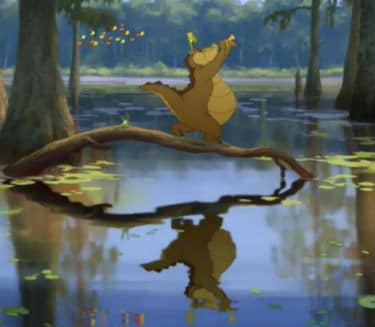
Photo: Disney
The music is jazzy and upbeat, calling to mind the setting of New Orleans and the Jazz Age. This is appropriate, since that is the setting of the film, and it works wonderfully. The songs are in a wide variety of styles to highlight the different musical styles of New Orleans. I can’t listen to this film without tapping my toes. It’s that catchy. The directors talked about food and music as being two critical parts of New Orleans culture, and they tried to capture that in the film.
ANIMATION
From what I read and heard, the animation style of The Princess and the Frog was inspired by both Lady and the Tramp and Bambi, for the city and bayou scenes, respectively. The directors loved the classic animation of the early Disney films, particularly these two for these settings.

Photo: Disney
This was also the first 2D animation film to come out of the Studio since Home on the Range and the five-year hiatus. Sadly, this would be the last 2D full-length animated film to come out of the Disney Animation Studio, as they made the transition to computer generated animation.
The design of some characters is interesting and fun. Tiana is left-handed with dimples, like her actor, Anika Noni Rose. The design of Lawrence was based on the work of John Lounsbery (one of the Nine Old Men) and was described as “cartoony and very solidly drawn,” with a splash of Mr. Smee by Ollie Johnston thrown in there.
Prince Naveen, the directors remember, was a challenge because they wanted a masculine, handsome, and charismatic prince that wasn’t just a prop for the princess. One of the directors pointed out that the prince is usually the most thankless part to animate in the film, and in this film, I think he came out alright.
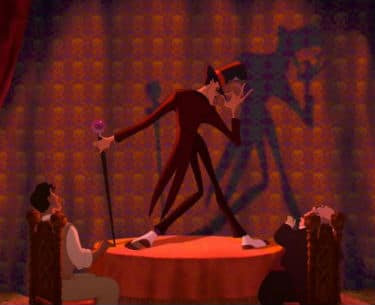
Photo: Disney
Bruce Smith, an excellent draftsman and animator, was in charge of animating the villain, Dr. Facilier, or The Shadowman. The directors called him a “slinky and cool” villain that people knew was “bad in a good way.” They’re not wrong.
The art for the song “Almost There” was based on Tiana’s restaurant flyer, which was inspired by the art of Aaron Douglas. It’s minimal animation, and as an alternate setting, it works wonderfully and looks great.
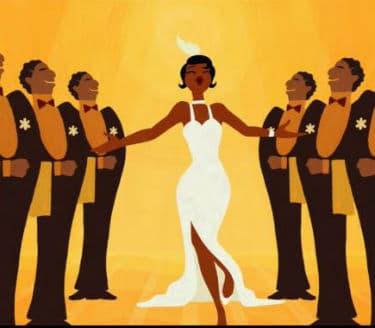
Photo: Disney
Additionally, the “Almost There” scene didn’t get cleaned up by the clean-up animation; it went from animation to color, switching that step. This was one of the last pieces of the movie to be completed, and it didn’t go through the same process that other scenes did, to keep it separate.
The team also tried something new in this film; they did what they referred to as layout animatics. They put the scenes together, with layout and lighting, and then watched the film before animating it, to get a sense of the film before animating it. This was something that John Lasseter suggested; since Pixar does their films that way, he thought it might work at Disney too. There are also wonderful effects in this movie, from the rain to the fire to all the shadows. It’s just a gorgeously done movie.
PLOT
The Princess and the Frog is set in the Roaring ’20s in New Orleans and opens with two little girls hearing the story of “The Frog Prince.” Charlotte said that she would do anything to marry a prince, while the other, Tiana, said she would never kiss a frog.

Photo: Disney
Tiana and her dad have a dream to own their own restaurant one day, and after his death, Tiana takes two jobs to save up and open their dream place. She is so close but is outbid at the last minute. With her dream shattered, she wishes on a star and encounters a talking frog, who turns out to be an enchanted visiting prince. When he promises to reward her for kissing him and breaking the spell, she agrees to kiss him and finds herself turned into a frog.
While Tiana was working to save up for her restaurant, visiting Prince Naveen arrived in the city. After his parents cut him off, he knows he needs to marry a rich young lady or get a job (which he has no desire to do). With his servant Lawrence, Naveen meets up with the Shadowman, who uses voodoo to give people what they want (with a loophole). He turns Naveen into a frog and Lawrence into Naveen.
The Shadowman has a sinister plot to take over the city and is working with his friends on the other side, and plans to use Lawrence and Naveen to succeed in that plot. Lawrence/Naveen woos Charlotte, Tiana’s prince-obsessed friend, while Tiana and Naveen set out on a journey through the bayou, in search of a way to break the spell on them.
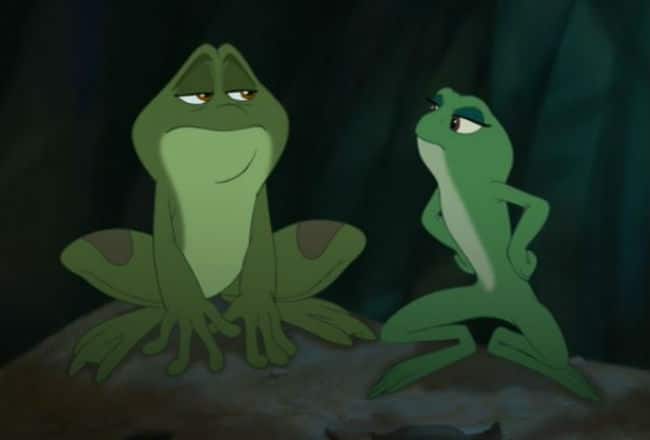
Photo: Disney
Joined by Louis, the trumpet-playing alligator and Ray, the firefly who is in love with a star, Tiana and Naveen try to become human again while learning to get along, avoiding the Shadowman, learning to become better versions of themselves, and falling in love. Will they become human again? Will Tiana get her restaurant?
SOURCE MATERIAL
Pixar and John Lasseter had been working on a version of the story for Pixar, but when John Lasseter moved to Disney, he brought the story with him. The setting was New Orleans, John Lasseter and Walt Disney’s favorite city in the world, and the project began in 2006. Disney had played with the idea before as well, and the firefly and star romance was something that came out of those early drafts.
The Princess and the Frog is based on the fairy tales “The Frog Prince” and The Frog Princess.” It was originally called The Frog Princess, but the Studio got a lot of complaints about the title being racially insensitive. They got enough criticism for having the first African American princess spend most of the movie as a frog (and, I mean, I can see that as an issue), but the idea that the title implied she was animalistic bothered people a lot.
Her name was also originally Maddy, and she worked as a maid. This was changed because Maddy sounds similar to Mammy, and the maid plot seemed to support negative stereotypes. I get the feeling that the original story was more of a “Cinderella” story with a dash of “The Frog Prince,” because there are aspects of “The Frog Prince” that are a bit…challenging, I’ll say, to adapt to a children’s film.
“The Frog Prince” is the name that most of us associate with “The Frog King, or Iron Heinrich,” by the Brothers Grimm. This tells you right away that it’s going to be a bit gruesome and bloody (the Grimm tales are usually grim). It starts off with a princess.
This princess drops her golden ball into a well and is upset. She begins to cry and hears a voice asking why she’s crying. It turns out that there is a frog there, who tells her that if she agrees to take him home to be her beloved pet and companion, he’ll get the ball back for her. She agrees, but promptly ditches the frog. The frog follows her home and the princess’ father tells her that she has to keep her promise.
When it comes time for the princess to let the frog sleep on her pillow, and he threatened to tell her father that she’s not keeping her promises, she gets annoyed. Picking up the frog, she chucks him into the wall to kill him. Of course, he turns into a handsome prince. Her father arranges their marriage and they fall in love because she broke the spell. And at the end, we learn that Iron Heinrich was a servant of the king, who put iron hoops around his heart when his master was enchanted so his heart wouldn’t break.
They all just moved past the whole murder thing, I suppose.
“The Frog Princess, or Vasilisa the Wise,” is an underrated gem. It’s a Russian tale that follows the beautiful princess Vasilisa the Wise who was turned into a frog by her jealous father. She and the prince meet the same way that the characters meet in “The Frog Prince,” but her prince, Ivan, takes her home and marries her.
She proves her worth through a series of tests, and when Ivan finds out that she’s really a beautiful princess, he burns her frog skin (not realizing that this condemns her to be the prisoner of an evil giant). Ivan sets out on a journey to save his wife, passing a series of tests before they reach their happily ever after.
These two stories, I think, are the ones that most lead into The Princess and the Frog; other than the obvious frog connections, though I suppose there are still splashes of “Cinderella.” The end story is a collection of European tales with a unique New Orleans flavor.
The 2000’s
In 2009, the financial crisis and recession continued. People have called it the worst financial crisis since the Great Depression of the 1930’s. Housing prices continued to drop and unemployment continued to rise. Many governments around the world dealt with the issue by adding money to the national economies, hoping to avoid another Great Depression. By the end of the year, the market had started to turn around and most people believed that the worst was over (though unemployment continued to increase).
This was also the year of swine flu, so that’s exciting.
2009 was also the year Michael Jackson died, and the year of Captain Phillips and the hijacking of his ship,, deadly bushfires in Australia, earthquakes, protests in Nepal, the collapse of the government of Iceland, Russia shutting down their gas pipeline to Europe, a state of emergency in Thailand, the president of Fiji suspending their Constitution, a coup in Madagascar, and North Korea conducting their second nuclear test.
This was also the year that Israel and Hamas declared a ceasefire in the Gaza War, more countries joined the EU, and President Barack Obama began his first term as President of the US.
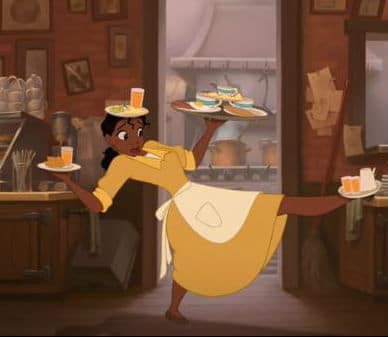
Photo: Disney
How does all this relate to The Princess and the Frog? I think that this is a case of remembering the beauty around us. I also think that The Princess and the Frog emphasizes the importance of things outside of money. There are things that are more important than things, like family and love, and that’s important to remember during a terrible recession.
LESSONS LEARNED
From The Princess and the Frog, I am reminded that dreams take hard work to achieve. It’s not enough to just wish and dream. This also fit into a time when unemployment was rising; it might take more time to achieve your dreams, but through hard work, you still can.
The film also teaches that there are things more important than money or success. Family and love are the most important things in the world, and we shouldn’t let anything make us forget that.
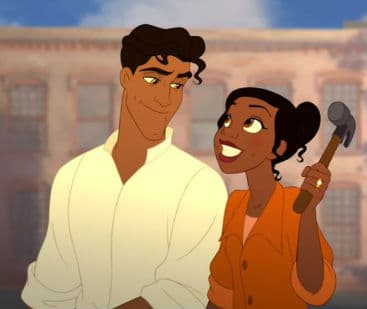
Photo: Disney
The next lesson is that there is a time to work and a time to play. If you only work, you live a half life, and if you only play, you aren’t living a complete life either. Tiana learns that she can have fun on occasion, even when she is perusing her dream, while Naveen learns about the importance of hard work.
Finally, don’t lose sight of what is important and don’t sacrifice that for anything less.
Also, I think that a side note here that I found interesting is that Tiana and Naveen don’t change each other, not really. They change through spending time with each other, but it’s more like they bring out the best in each other and inspire the other to change, becoming their best selves.
DOES IT HOLD UP?
Honestly, I love this movie. When it comes to fun and beautiful Disney movies, The Princess and the Frog is one that should not be forgotten. The animation in this film is stunning, and worth the watch just for that. However, when you add the fun characters, the catchy music, and the enjoyable story, this becomes a film that you don’t want to miss.
For next week: Tangled
If you enjoyed this post and the others in the Revisiting Disney series, and have found yourself wishing that you could find them all in one convenient and bound book with eight extra essays, there is an option for you! Check out A Journey Through Disney: My Look Back Through Disney Canon, now available on Amazon as both a Kindle book ($4.99) and a paperback ($11.99).
OTHER SOURCES:
https://thewaltdisneycompany.com/about-disney/disney-history
http://www.imdb.com
http://studioservices.go.com/disneystudios/history.html
http://www.thepeoplehistory.com
Bailey, Adrian. Walt Disney’s World of Fantasy. Everest House Publishers. New York, New York. 1982.
Finch, Christopher. The Art of Walt Disney: From Mickey Mouse to the Magic Kingdom. Harry N. Abrams, Inc. New York, New York. 1975.
Johnston, Ollie and Frank Thomas. The Disney Villain. Hyperion. New York, New York. 1993.
Thomas, Bob. Disney’s Art of Animation From Mickey Mouse to Hercules. Hyperion. New York, New York. 1992.
ARE YOU A ROMANCE FAN? FOLLOW THE SILVER PETTICOAT REVIEW:
 Our romance-themed entertainment site is on a mission to help you find the best period dramas, romance movies, TV shows, and books. Other topics include Jane Austen, Classic Hollywood, TV Couples, Fairy Tales, Romantic Living, Romanticism, and more. We’re damsels not in distress fighting for the all-new optimistic Romantic Revolution. Join us and subscribe. For more information, see our About, Old-Fashioned Romance 101, Modern Romanticism 101, and Romantic Living 101.
Our romance-themed entertainment site is on a mission to help you find the best period dramas, romance movies, TV shows, and books. Other topics include Jane Austen, Classic Hollywood, TV Couples, Fairy Tales, Romantic Living, Romanticism, and more. We’re damsels not in distress fighting for the all-new optimistic Romantic Revolution. Join us and subscribe. For more information, see our About, Old-Fashioned Romance 101, Modern Romanticism 101, and Romantic Living 101.
